Module 11 - Microwave Principles Pages
i,
1-1, 1-11,
1-21,
1-31,
1-41,
1-51,
1-61,
2-1,
2-11, 2-21,
2-31,
2-41,
2-51,
2-61,
3-1,
3-11,
AI-1,
Index-1,
Assignment 1,
Assignment 2
Pages 1-51 through 1-60
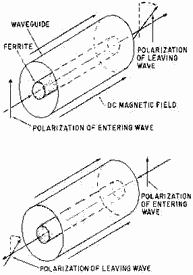
Figure 1-76. - Faraday rotation.
Q-59. Ferrite devices are useful in microwave applications because they possess
what properties?
Q-60. Which of the two types of electron motion (orbital movement and electron
spin) is more important in the explanation of magnetism?
Q-61. The interaction between an external field and the binding force of an atom
causes electrons to do what?
Q-62. The resonant frequency of electron wobble can be changed by variation of
what force?
Q-63. Rotating the plane of polarization of a wavefront by passing it through
a ferrite device is called what?
Summary
This chapter has presented information on waveguide theory and application. The
information that follows summarizes the important points of this chapter.
Waveguides are the primary methods of transporting microwave
energy. Waveguides have fewer losses and greater power-handling capability than
transmission lines. The physical size of the waveguides becomes too great for use
at frequencies less than 1000 megahertz. Waveguides are made in three basic shapes,
as shown in the first illustration. The wide, or "a," dimension determines the frequency
range of the waveguide, and the narrow, or "b," dimension determines power-handling
capability as shown in the second illustration. Waveguides handle a small range
of frequencies both above and below
the primary operating frequency. Energy is transported through waveguides by
the interaction of electric and magnetic fields, abbreviated E FIELD and H FIELD,
respectively. The density of the E field varies at the same rate as the applied
voltage. If energy is to travel through a waveguide, two BOUNDARY CONDITIONS must
be met: (1) An electric field, to exist at the surface of a conductor, must be perpendicular
to the conductor, and (2) a varying magnetic field must exist in closed loops parallel
to the conductors and perpendicular to the electric field.
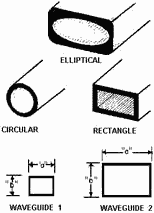
Wavefronts travel down a waveguide by reflecting from
the side walls in a zigzag pattern, as shown in the figure. The striking angle,
or angle of incidence (θ), is the same as the angle of reflection (θ), causing the
reflected wavefront to have the same shape as the incident wavefront. The velocity
of wavefronts traveling down a waveguide is called the GROUP VELOCITY because of
the zigzag path of these wavefronts. The group velocity is slower than the velocity
of wavefronts through space.
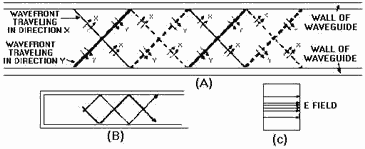
The Modes in waveguides are divided into two categories: (1)
the TRANSVERSE ELECTRIC (TE) mode and (2) the TRANSVERSE Magnetic (TM) mode. Subscripts
are used to complete the description of the various TE and TM modes. The dominant
mode for rectangular waveguides is shown in the figure.
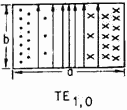
Waveguide Input/Output Modes are divided into three basic categories:
PROBES, LoopS, and SLOTS. Size, shape, and placement in the waveguide are critical
factors in the efficiency of all three input/output methods.
Waveguide/Impedance Matching is often necessary to reduce reflections
caused by a MIsMATCH between the waveguide and the load. Matching devices called
IRIsES, shown in the illustration, are used to introduce either capacitance or inductance
(or a combination of both) into a waveguide. Conductive POSTS and SCREWS can also
be used for impedance matching in waveguides.
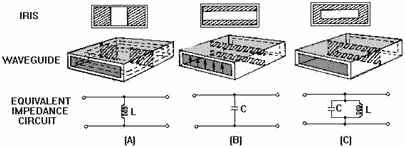
Waveguide Terminations prevent standing waves at the end of
a waveguide system. They are usually specially constructed HORNS or absorptive loads
called Dummy Loads.
Waveguide Plumbing refers to the bends, twists, and joints necessary
to install waveguides. E bends, H bends, and twists must have a radius greater than
two wavelengths. The CHOKE JOINT, shown in the figure, is most often used to connect
two pieces of waveguide. The ROTATING JOINT is used when a waveguide must be connected
to a rotating load such as an antenna.

Directional Couplers are devices that permit the sampling of
the energy in a waveguide. Directional couplers may be constructed to sample energy
in one direction only or in both directions. The energy removed by the directional
coupler is a small sample that is proportional to the magnitude of the energy in
the waveguide. An example of a directional coupler is shown in the illustration.
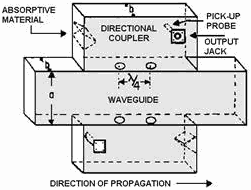
A Resonant Cavity is any space completely enclosed by conductive
walls that can contain oscillating electromagnetic fields and can possess resonant
properties. Several cavity shapes are shown in the illustration.
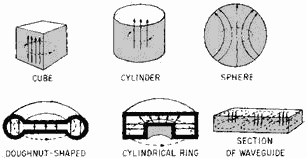
Waveguide Junctions are of several basic types. The T-JUNCTION
may be either of the E- TYPE or the H-TYPE. The effect on the input energy depends
upon which arm is used as the input. The MAGIC-T HYBRID JUNCTION, shown at the right,
is a combination of the E- and H-type T junctions.
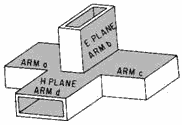
Ferrite Devices combine magnetic properties with a high resistance
to current flow. Ferrites are constructed from compounds of ferrous metal oxides
to achieve the desired characteristics. The fact that the spin axes of electrons
will wobble at a natural resonant frequency when subjected to an external magnetic
field is the basic principle of operation of ferrite devices. The position of a
typical ferrite device within a waveguide is shown in the figure.

Answers to Questions Q1 Through Q63
A-1. Microwave region.
A-2. Electromagnetic field theory.
A-3. The electromagnetic fields are completely confined.
A-4. Conductive material.
A-5. Copper loss.
A-6. Skin effect.
A-7. Air.
A-8. Physical size.
A-9. The characteristics of the dielectric of a capacitor.
A-10. a shorted quarter-wave section called a metallic insulator.
A-11. The "a" dimension.
A-12. The bus bar becomes wider.
A-13. Energy will no longer pass through the waveguide.
A-14. The interaction of the electric and magnetic fields.
A-15. The relative strength of the field.
A-16. Magnetic lines of force must form a continuous closed loop.
A-17. The H lines cancel.
A-18. The field must be perpendicular to the conductors.
A-19. Decrease to zero.
A-20. The angles are equal.
A-21. Cutoff frequency.
A-22. Slower.
A-23. Group velocity.
A-24. Mode of operation.
A-25. Dominant mode.
A-26. 1.71 times the diameter.
A-27. Transverse electric (TE) and transverse magnetic (TM).
A-28. TE.
A-29. Second.
A-30. First.
A-31. Size and shape.
A-32. Slots and apertures.
A-33. Standing waves that cause power losses, a reduction in power-handling capability,
and an increase in frequency and sensitivity.
A-34. Metal plates.
A-35. Inductive.
A-36. As a shunt resistance.
A-37. Horn.
A-38. Characteristic impedance.
A-39. Absorb all energy without producing standing waves.
A-40. Heat.
A-41. Reflections.
A-42. Greater than 2 wavelengths.
A-43. Choke joint.
A-44. Improperly connected joints or damaged inner surface.
A-45. Sampling energy within a waveguide.
A-46. 1/4 wavelength.
A-47. Absorb the energy not directed at the pick-up probe and a portion of the
overall energy.
A-48. The wavefront portions add.
A-49. The reflected energy adds at the absorbent material and is absorbed.
A-50. Size and shape of the cavity.
A-51. Probes, loops, and slots.
A-52. The area of maximum H lines.
A-53. E-type and H-type.
A-54. The junction arm extends in a direction parallel to the H lines in the
main waveguide.
A-55. E-type and H-type.
A-56. Low power-handling capability and power losses.
A-57. Basic E-type junctions.
A-58. High-power duplexes.
A-59. Magnetic properties and high resistance.
A-60. Electron spin.
A-61. Wobble at a natural resonant frequency.
A-62. The applied magnetic field.
A-63. Faraday rotation.
| - |
Matter, Energy,
and Direct Current |
| - |
Alternating Current and Transformers |
| - |
Circuit Protection, Control, and Measurement |
| - |
Electrical Conductors, Wiring Techniques,
and Schematic Reading |
| - |
Generators and Motors |
| - |
Electronic Emission, Tubes, and Power Supplies |
| - |
Solid-State Devices and Power Supplies |
| - |
Amplifiers |
| - |
Wave-Generation and Wave-Shaping Circuits |
| - |
Wave Propagation, Transmission Lines, and
Antennas |
| - |
Microwave Principles |
| - |
Modulation Principles |
| - |
Introduction to Number Systems and Logic Circuits |
| - |
- Introduction to Microelectronics |
| - |
Principles of Synchros, Servos, and Gyros |
| - |
Introduction to Test Equipment |
| - |
Radio-Frequency Communications Principles |
| - |
Radar Principles |
| - |
The Technician's Handbook, Master Glossary |
| - |
Test Methods and Practices |
| - |
Introduction to Digital Computers |
| - |
Magnetic Recording |
| - |
Introduction to Fiber Optics |
| Note: Navy Electricity and Electronics Training
Series (NEETS) content is U.S. Navy property in the public domain. |
Related Pages on RF Cafe
|


















